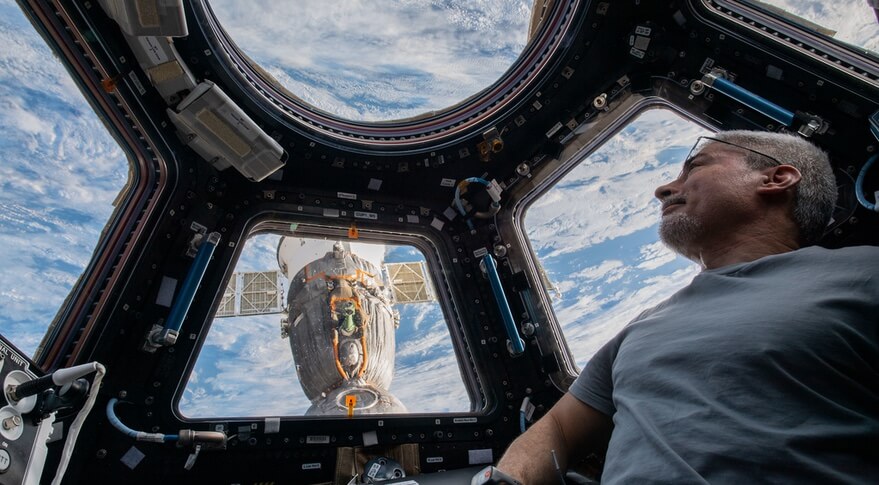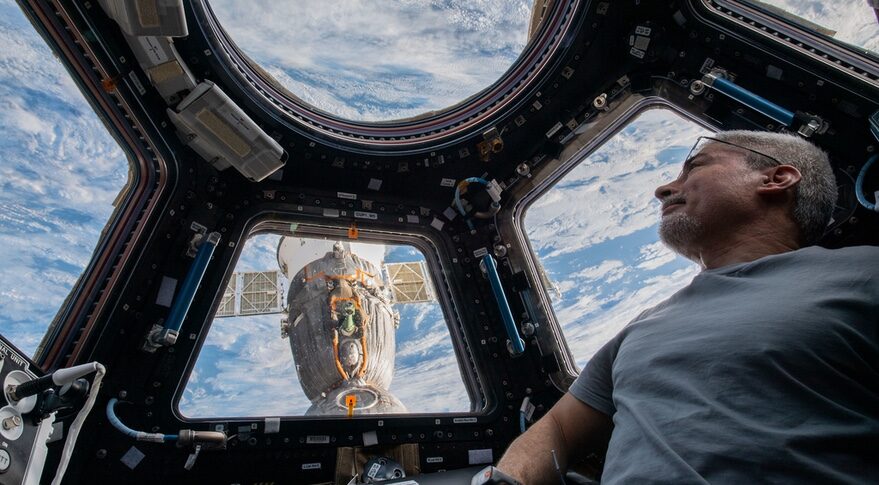
Space station operations remain normal despite geopolitical tensions (Image Credit: Space News)

WASHINGTON — Russia’s invasion of Ukraine has not affected operations of the International Space Station or plans for a NASA astronaut to return home on a Soyuz spacecraft late this month, according to agency officials.
At a March 14 briefing about a pair of upcoming spacewalks at the station, Joel Montalbano, NASA ISS program manager, emphasized repeatedly that the geopolitical tensions on Earth between Russia and the West have not extended to the ISS.
“Nothing has changed in the last three weeks,” he said. “We’re not seeing any impacts from what’s going on around us. We’re able to do our jobs. We’re aware of what’s going on, but we are able to do our jobs and continue operations.”
That includes, he said, the March 18 launch of the Soyuz MS-21 spacecraft to the ISS, bringing three Russian cosmonauts to the station. On March 30, the Soyuz MS-19 spacecraft will return to Earth with Russian cosmonauts Anton Shkaplerov and Pyotr Dubrov on board, along with NASA astronaut Mark Vande Hei.
There had been media reports in recent days speculating that Vande Hei might be denied a seat on that Soyuz, based in part on a Russian video that showed Shkaplerov and Dubrov leaving without Vande Hei, taking with them the Russian segment of the station. Montalbano, though, said that Vande Hei would return as planned on Soyuz MS-19.
“I can tell you for sure that Mark is coming home on that Soyuz,” he said. “We are in communications with our Russian colleagues. There’s no fuzz on that.”
He reiterated that later in the briefing, noting that the ISS partners head a “readiness review” recently for that return. “Everybody confirmed that the three people coming home will be Anton, Pyotr and Mark.”
NASA’s role in the recovery operations after landing will be unchanged, he said, including the use of a NASA Gulfstream G5 jet to pick up Vande Hei and return him to Houston. NASA has “just under 20” people involved in those operations, which includes both those who come over on the jet as well as U.S. embassy personnel in Kazakhstan.
Other activities at the station are also proceeding as planned. That includes a spacewalk March 15 by NASA astronauts Kayla Barron and Raja Chari to install equipment that will be used by new solar arrays to be added later this year. Another spacewalk, scheduled for March 23, will involve a variety of maintenance work on the station’s exterior. The Ax-1 private astronaut mission by Axiom Space remains scheduled for launch March 30 on a SpaceX Crew Dragon spacecraft.
Montalbano said that work continues to finalize a seat barter agreement between NASA and Roscosmos that would allow NASA astronauts to fly on Soyuz spacecraft in exchange for flying Roscosmos cosmonauts on commercial crew vehicles. “We still plan to work the crew swap,” he said, with cosmonauts scheduled to train at the Johnson Space Center and at SpaceX’s California headquarters and NASA astronauts going to Star City, Russia. “Today, we’re continuing to work those agreements.”
Roscosmos has also stated that ISS operations, including the upcoming Soyuz MS-19 return, remain normal. Roscosmos said in a statement published by the Tass news service that Vande Hei would return on Soyuz MS-19 along with Shkaplerov and Dubrov. “Roscosmos has never let anybody doubt its reliability as a partner,” the agency stated.
One reason for that is that neither NASA nor Roscosmos can operate the station on its own. “Space Station was designed to be interdependent,” Montalbano said. “It’s not a process where one group can separate from the other. We need everything together in order to be successful.”
The U.S. segment, he noted, handles “non-propulsive” attitude control as well as offers communications and surplus power for the Russian segment. Russia, in turn, provides propulsion to maintain the station’s orbit and for additional attitude control. A Cygnus cargo spacecraft currently attached to the station will perform a test this spring of reboosting the station, he said, but even that test will require Russian thrusters to provide attitude control.
Robyn Gatens, ISS director at NASA Headquarters, offered a similar message in a March 12 interview after a panel discussion at the South by Southwest festival in Austin, Texas. “It would be a difficult situation if we were to try to operate independently from our partners,” she said. “We are interdependent on our partners and we hope that will continue to be the case.”
That interdependence does raise questions in the longer term, though. While Canada, Europe and Japan have all backed NASA’s plan to extend ISS operations from 2024 to 2030, Russia was skeptical even before the invasion of Ukraine. Now, Russia may be even less supportive of a long-term future for the station even if it is willing to continue operations in the near term.
“If we have time, that opens up some options for us” to plan on operating the station without Russia, Gatens said. “I think it would be difficult and limit our goals for the space station through 2030 if we had to focus our energy and resources on trying to backfill the capability that one of our partners is providing.”








